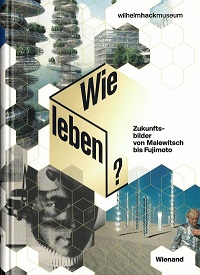On Living. Images of the Future from Malevich to Fujimoto
From time immemorial, people have occupied themselves with concepts and visions dealing with the shaping of the world of tomorrow: How do we want to live? What should our homes be like? How do we want to work? Artists, architects and scientists in particular have shaped our society with their visions for the future. And yet our present is still the future of yesterday. Some ideas remain visions, others have been realised. The exhibition ‘On Living. Images of the Future from Malevich to Fujimoto’ in the Wilhelm-Hack-Museum presents drafts for the future as conceived in the fields of art, architecture and design from the Russian avant-garde to our own present digital age and traces a multifaceted history of the future. Featuring over 300 works by more than 100 artists, architects and designers, the exhibition shows significant life plans and visions of the 20th and 21st centuries. Important art historical, cultural and industrial examples are divided up into some 20 different thematic focal points. The constructive character evident in the works of Kasimir Malevich or El Lissitzky with their purely fictional spatial constructions point to an aesthetic societal utopia. Movements like the De Stijl group or educational institutions such as the Bauhaus emphasised an integral configuration combining life, architecture, design and art. The desire to merge aspects of nature and dwelling can be followed from Hermann Finsterlin’s organic crystalline drafts to the open ground plans by Ludwig Mies van der Rohe and the hovering structures by Arata Isozaki in addition to the current approaches taken by Sou Fujimoto. The development of industrialisation, which forms the backdrop for numerous visions, is addressed with the help of photographs by August Sander, Bernd and Hilla Becher as well as Robert Häusser. A close cooperation between industry and art has frequently given rise to advances that enable a new definition and design of the future. The Ulm School of Design, for example, tried to establish products with a system character intended to simplify our lives greatly through a connection between art and everyday life. A new sense of life was attained using new materials like plastic and the example of the aesthetic achievements such as those visible in the designs of Verner Panton or Luigi Colani. A generation of designers and artists emerged in the mid 20th century like the members of the ZERO group that celebrated experimentation, pushing the boundaries, in a never-before-seen manner. They drafted organic interiors and dreamt of living on Mars. The exhibition is rounded off by referencing the challenges that are intrinsic to our own times. Contemporary artists like Tomás Saraceno, Roij Ikeda, Terreform ONE, Andreas Gursky and Davide Quayola stimulate thought: What is the impact of globalisation and climate on urban restructurings? What happens to caring in the jungles of the megacities? How can we make efficient use of our environment and also preserve it for future generations? What changes accompany the digital revolution? ‘About Living – Images of the Future from Malevich to Fujimoto’ focuses attention on the interrelationships between social and industrial developments as well as innovations in the fields of art, architecture and design. Four new artistic projects by Luka Fineisen, Christoph Girardet, Antje Schiffers and Jean-Louis Schoellkopf address in different ways the work environment at BASF. The exhibition was initiated and finally supported by BASF SE in conjunction with BASF 150.
Curators: Jana Franze, Astrid Ihle, Theresia Kiefer, Yvonne Scheja, René Zechlin

